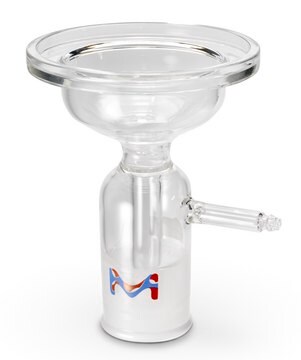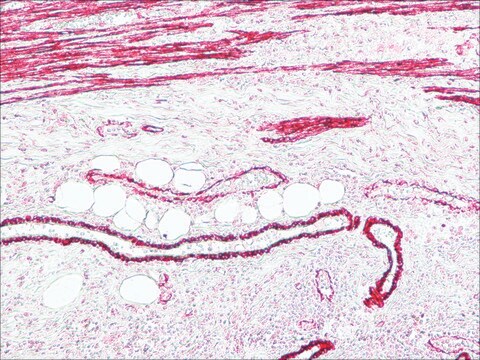96013
Abberior® STAR 635, maleimide
for STED application
Sign Into View Organizational & Contract Pricing
All Photos(1)
About This Item
UNSPSC Code:
12352200
NACRES:
NA.32
Recommended Products
Assay
≥80.0%
form
solid
solubility
DMF: 0.25 mg/mL, clear
fluorescence
λex 640 nm; λem 655 nm±10 nm in PBS, pH 7.4
storage temp.
−20°C
General description
Absorption Maximum, λmax: 635 nm (PBS, pH 7.4)
Extinction Coefficient, ε(λmax): 110,000 M-1cm-1 (PBS, pH 7.4)
Correction Factor, CF260 = ε260/εmax: 0.26 (PBS, pH 7.4)
Correction Factor, CF280 = ε280/εmax: 0.38 (PBS, pH 7.4)
Fluorescence Maximum, λfl: 656 nm (aq. acetonitrile; MeOH)
655 nm (PBS, pH 7.4)
Recommended STED Wavelength, λSTED: 750 −780 nm
Fluorescence Quantum Yield, η: 0.88 (PBS, pH 7.4)
Fluorescence Lifetime, τ: 2.8 (PBS, pH 7.4)
Extinction Coefficient, ε(λmax): 110,000 M-1cm-1 (PBS, pH 7.4)
Correction Factor, CF260 = ε260/εmax: 0.26 (PBS, pH 7.4)
Correction Factor, CF280 = ε280/εmax: 0.38 (PBS, pH 7.4)
Fluorescence Maximum, λfl: 656 nm (aq. acetonitrile; MeOH)
655 nm (PBS, pH 7.4)
Recommended STED Wavelength, λSTED: 750 −780 nm
Fluorescence Quantum Yield, η: 0.88 (PBS, pH 7.4)
Fluorescence Lifetime, τ: 2.8 (PBS, pH 7.4)
Application
- Abberior™ Star 635 maleimide has been used for single-molecule FRET (Förster resonance energy transfer) spectroscopy for protein dynamics in live cells.
- Abberior™ STAR 635 goat anti-rabbit antibody has been used for STED (stimulated emission depletion) imaging of primary cultured striatal neurons obtained from rats.
- Abberior™ STAR 635 anti-rabbit antibody has been used for STED imaging of non-sensory supporting cells obtained from cochlea of rats and mice.
- Abberior™ STAR 635 conjugated with secondary antibody has been used for STED imaging of microtubules in cells.
Suitability
Designed and tested for fluorescent super-resolution microscopy
Other Notes
Legal Information
6538 is a trademark of American Type Culture Collection
abberior is a registered trademark of Abberior GmbH
related product
Product No.
Description
Pricing
Storage Class Code
13 - Non Combustible Solids
WGK
WGK 3
Flash Point(F)
Not applicable
Flash Point(C)
Not applicable
Choose from one of the most recent versions:
Certificates of Analysis (COA)
Lot/Batch Number
Don't see the Right Version?
If you require a particular version, you can look up a specific certificate by the Lot or Batch number.
Already Own This Product?
Find documentation for the products that you have recently purchased in the Document Library.
Iwo König et al.
Nature methods, 12(8), 773-779 (2015-07-07)
Single-molecule methods have become widely used for quantifying the conformational heterogeneity and structural dynamics of biomolecules in vitro. Their application in vivo, however, has remained challenging owing to shortcomings in the design and reproducible delivery of labeled molecules, the range
Hans Blom et al.
PloS one, 8(9), e75155-e75155 (2013-09-24)
The phosphoprotein DARPP-32 (dopamine and cyclic adenosine 3´, 5´-monophosphate-regulated phosphoprotein, 32 kDa) is an important component in the molecular regulation of postsynaptic signaling in neostriatum. Despite the importance of this phosphoprotein, there is as yet little known about the nanoscale
Jenu Varghese Chacko et al.
Journal of biomedical optics, 19(10), 105003-105003 (2014-10-08)
Atomic force microscopes (AFM) provide topographical and mechanical information of the sample with very good axial resolution, but are limited in terms of chemical specificity and operation time-scale. An optical microscope coupled to an AFM can recognize and target an
Arnaud P Giese et al.
Development (Cambridge, England), 139(20), 3775-3785 (2012-09-20)
Vangl2 is one of the central proteins controlling the establishment of planar cell polarity in multiple tissues of different species. Previous studies suggest that the localization of the Vangl2 protein to specific intracellular microdomains is crucial for its function. However
S W Hell et al.
Optics letters, 19(11), 780-782 (1994-06-01)
We propose a new type of scanning fluorescence microscope capable of resolving 35 nm in the far field. We overcome the diffraction resolution limit by employing stimulated emission to inhibit the fluorescence process in the outer regions of the excitation
Our team of scientists has experience in all areas of research including Life Science, Material Science, Chemical Synthesis, Chromatography, Analytical and many others.
Contact Technical Service




